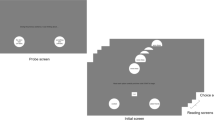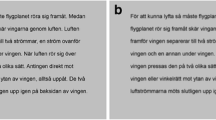Abstract
Though the testing-effect can be boosted by including a restudy phase after answering test questions, we do not know precisely why it does so. One possible explanation is being tested here. The present study measured attention allocation during initial reading and rereading with a remote eye tracker to gain information on the cognitive processes during restudy, with and without prior testing. The results show that at the final study moment, students in the study-test-condition attended longer to information pertaining to the initial test questions as compared to students in the study-only condition (i.e., who did not take the test). No differences in attention allocation were found for information only questioned on a posttest 1 week later. In addition, it was found that performance on the initial test questions heavily affected which information students restudy; students in the study-test-condition paid namely more attention to the answers of questions they answered incorrectly during the initial test than to the answers of the questions they answered correctly on the initial test.

Similar content being viewed by others
Notes
Independent sample t tests were used because there was no significant correlation between dwell time on targeted and non-targeted AOIs and between performance on identical and new posttest questions.
References
Andre, T. (1979). Does answering high-level questions while reading facilitate productive learning? Review of Educational Research, 49(2), 280–318. doi:10.3102/00346543049002280.
Bisanz, G. L., Vesonder, G. T., & Voss, J. F. (1978). Knowledge of one’s own responding and the relation of such knowledge to learning. Journal of Experimental Child Psychology, 25, 116–128. doi:10.1016/0022-0965(78)90042-5.
Britt, M. A., & Angliskas, C. (2002). Improving students’ ability to identify and use source information. Cognition and Instruction, 20, 485–522. doi:10.1207/S1532690XCI2004_2.
Carrier, M., & Pashler, H. (1992). The influence of retrieval on retention. Memory & Cognition, 20, 633–642. doi:10.3758/BF03202713.
Cerdán, R., Vidal- Abarca, E., Martínez, T., Gilabert, R., & Gill, L. (2009). Impact of question-answering tasks on search processes and reading comprehension. Learning & Instruction, 19, 13–27. doi:10.1016/j.learninstruc.2007.12.003.
Dirkx, K. J. H., Kester, L., & Kirschner, P. A. (2014). The testing effect for learning principles and procedures from texts. The Journal of Educational Research, 1–8. doi:10.1080/00220671.2013.823370/
Gates, A. I. (1917). Recitation as a factor in memorizing. Archives of Psychology, 6(40), 1–104.
Goldman, S., & Rakestraw, J. (2000). Structural aspects of constructing meaning from text. In M. Kamil, P. Mosenthal, P. D. Pearson, & R. Barr (Eds.), Handbook of Reading Research (Vol. III, pp. 311–335). New York: Lawrence Erlbaum Associates.
Guthrie, J. T. (1971). Feedback and sentence learning. Journal of Verbal Learning and Verbal Behavior, 10, 23–28. doi:10.1016/S0022-5371(71)80088-9.
Hamilton, R. J. (1985). A framework for the evaluation of the effectiveness of adjunct questions and objectives. Review of Educational Research, 55, 47–85. doi:10.3102/00346543055001047.
Harlen, W. (2006). On the relationship between assessment for summative and formative purposes. In J. Gardner (Ed.), Assessment and learning (pp. 103–118). London, England: Sage Publications ltd.
Hasbrouck, J., & Tindal, G. A. (2006). Oral reading fluency norms: A valuable assessment tool for reading teachers. The Reading Teacher, 59, 636–644. doi:10.1598/RT.59.7.3.
Hyönä, J., Niemi, P., & Underwood, G. (1989). Reading long words embedded in sentences: Informativeness of word halves affects eye movements. Journal of Experimental Psychology: Human Perception and Performance, 15, 142–152. doi:10.1037/0096-1523.15.1.142.
Kapur, M. (2014). Productive failure in learning math. Cognitive Science, 38, 1008–1022. doi:10.1111/cogs.12107.
Kapur, M., & Toh, P. L. L. (2013). Productive failure: From an experimental effect to a learning design. In T. Plomp & N. Nieveen (Eds.), Educational design research–Part B: Illustrative cases (pp. 341–355). Enschede, the Netherlands: SLO.
Karpicke, J. D. (2009). Metacognitive control and strategy selection: Deciding to practice retrieval during learning. Journal of Experimental Psychology: General, 138, 469–486. doi:10.1037/a0017341.
Karpicke, J. D., Butler, A. C., & Roediger, H. L, I. I. I. (2009). Metacognitive strategies in student learning: Do students practice retrieval when they study on their own? Memory, 17, 471–479. doi:10.1080/09658210802647009.
Karpicke, J. D., & Grimaldi, P. J. (2012). Retrieval-based learning: A perspective for enhancing meaningful learning. Educational Psychology Review, 24, 401–418. doi:10.1007/s10648-012-9202-2.
Karpicke, J. D., & Roediger, H. L, I. I. I. (2007). Repeated retrieval during learning is the key to long-term retention. Journal of Memory and Language, 57, 151–162. doi:10.1016/j.jml.2006.09.004.
Kausler, D. H., Laughlin, P. R., & Trapp, E. P. (1963). Effects of incentive-set on relevant and irrelevant (incidental) learning in children. Child Development, 34(1), 195–199. doi:10.1111/j.1467-8624.1963.tb06021.x.
Kausler, D. H., & Trapp, E. P. (1962). Effects of incentive-set and task variables on relevant and irrelevant learning in serial verbal learning. Psychological Report, 10, 451–457. doi:10.2466/PR0.10.2.451-457.
Kornell, N., Hays, M. J., & Bjork, R. A. (2009). Unsuccessful retrieval attempts enhance subsequent learning. Journal of Experimental Psychology. Learning, Memory, and Cognition, 35, 989–998. doi:10.1037/a0015729.
McDaniel, M. A., Blischak, D. M., & Challis, B. (1994). The effects of test expectancy on processing and memory of prose. Contemporary Educational Psychology, 19(2), 230–248. doi:10.1006/ceps.1994.1019.
Metcalfe, J., & Kornell, N. (2003). The dynamics of learning and allocation of study time to a region of proximal learning. Journal of Experimental Psychology: General, 132, 530–542.
Pyc, M. A., & Rawson, K. A. (2010). Why testing improves memory: Mediator effectiveness hypothesis. Science, 330, 333–335. doi:10.1126/science.1191465.
Raaijmakers, J. G. W., & Shiffrin, R. M. (1981). Search of associative memory. Psychological Review, 88, 93–134. doi:10.1037/0033-295X.88.2.93.
Roediger, H. L, I. I. I., & Butler, A. C. (2011). The critical role of retrieval practice in long-term retention. Trends in Cognitive Science, 15, 20–27. doi:10.1016/j.tics.2010.09.003.
Roediger, H. L, I. I. I., & Karpicke, J. D. (2006). The power of testing memory: Basic research and implications for educational practice. Perspectives on Psychological Science, 1, 181–210. doi:10.1111/j.1745-6916.2006.00012.x.
Roediger, H. L., Putnam, A. L., & Smith, M. A. (2011). Ten benefits of testing and their applications to educational practice. In J. Mestre & B. Ross (Eds.), Psychology of learning and motivation: Cognition in education (pp. 1–36). Oxford: Elsevier. doi:10.1016/B978-0-12-387691-1.000.
Roll, I., Holmes, N. G., Day, J., & Bonn, D. (2012). Evaluating metacognitive scaffolding in guided invention activities. Instructional Science, 40, 691–710. doi:10.1007/s11251-012-9208-7.
Rothkopf, E. Z. (1966). Learning from written instructive materials: An exploration of the control of inspection behavior by test-like events. American Educational Research Journal, 3, 241–249. doi:10.3102/00028312003004241.
Rothkopf, E. Z., & Bisbicos, E. E. (1967). Selective facilitative effects of interspersed questions on learning from written materials. Journal of Educational Psychology, 58(1), 56–61. doi:10.1037/h0024117.
Son, L. K., & Metcalfe, J. (2000). Metacognitive and control strategies in study-time allocation. Journal of Experimental Psychology. Learning, Memory, and Cognition, 26(1), 204–221. doi:10.1037/0278-7393.26.1.204.
Spitzer, H. F. (1939). Studies in retention. The Journal of Educational Psychology, 30, 641–656. doi:10.1037/h0063404.
Thiede, K. T., & Dunlosky, J. (1999). Toward a general model of self-regulated study: An analysis of selection of items for study and self-paced study time. Journal of Experimental Psychology. Learning, Memory, and Cognition, 24, 1024–1037.
Van Gog, T., Paas, F., & Van Merriënboer, J. J. G. (2005). Uncovering expertise-related differences in troubleshooting performance: Combining eye movement and concurrent verbal protocol data. Applied Cognitive Psychology, 19, 205–221. doi:10.1002/acp.1112.
Van Gog, T., & Scheiter, K. (2010). Eye tracking as a tool to study and enhance multimedia learning. Learning and Instruction, 20(2), 95–99. doi:10.1016/j.learninstruc.2009.02.009.
Vidal-Abarca, E., Gilabert, R., & Rouet, J. F. (1998, July). The role of question type on learning from scientific text. Paper presented at the Meeting on Comprehension and Production of Scientific Texts, Aveiro, Portugal.
Author information
Authors and Affiliations
Corresponding author
Appendix
Appendix
The probability definition contains different symbols. The symbol P for example stands for probability and G stands for the situation for which you want to calculate the probability, such as the situation of throwing two (sum is two) with two dice. How do you calculate this probability? When you throw two dice, there are 6 × 6 = 36 possible outcomes (sum scores), because every dice has six sides, each with a different number of dots. For the situation (G) ‘sum is two’ there is only one possibility, namely that you throw one with the first dice and one with the second. Thus, there is only one possible outcome for ‘sum is two’ and 36 possible outcomes of throwing two dice. According to the formula P (sum is two) = 1/36.
Initial test question | Posttest question |
|---|---|
What does the symbol G in the formula stand for? | In the probability definition the symbol P is included. Wherefore stands P? |
Rights and permissions
About this article
Cite this article
Dirkx, K.J.H., Thoma, GB., Kester, L. et al. Answering questions after initial study guides attention during restudy. Instr Sci 43, 59–71 (2015). https://doi.org/10.1007/s11251-014-9330-9
Received:
Accepted:
Published:
Issue Date:
DOI: https://doi.org/10.1007/s11251-014-9330-9




